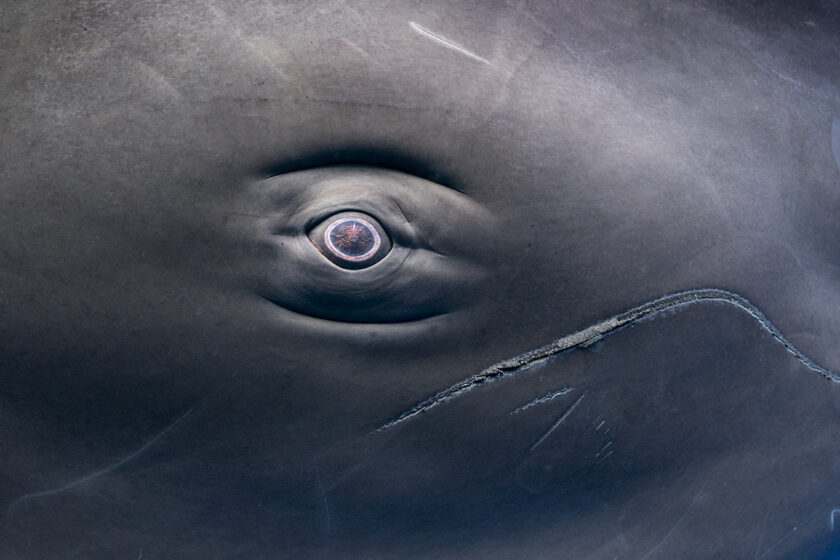The poem Whales Weep Not! by D.H. Lawrence begins like this: “They say the sea is cold, but the sea contains the hottest blood of all, and the wildest, the most urgent.” Well, I am no whale, but my blood was certainly pumping hot through my veins in step with the wild beating of my heart as I urgently put every ounce of energy into trying to keep with a 34-foot long sperm whale.
Biggest Predator on the Planet
Sperm whales (Physeter macrocephalus), or cachalot as they are called are the largest member in the family of toothed whales. Mature males (referred to as bulls) can reach impressive lengths between 52 feet / 16 metres to as much as 67 feet / 20.5 metres. Adult females (referred to as cows) run significantly smaller, averaging 36 feet in length / 11 metres. In either case, what we have is the largest living toothed predator on the planet.
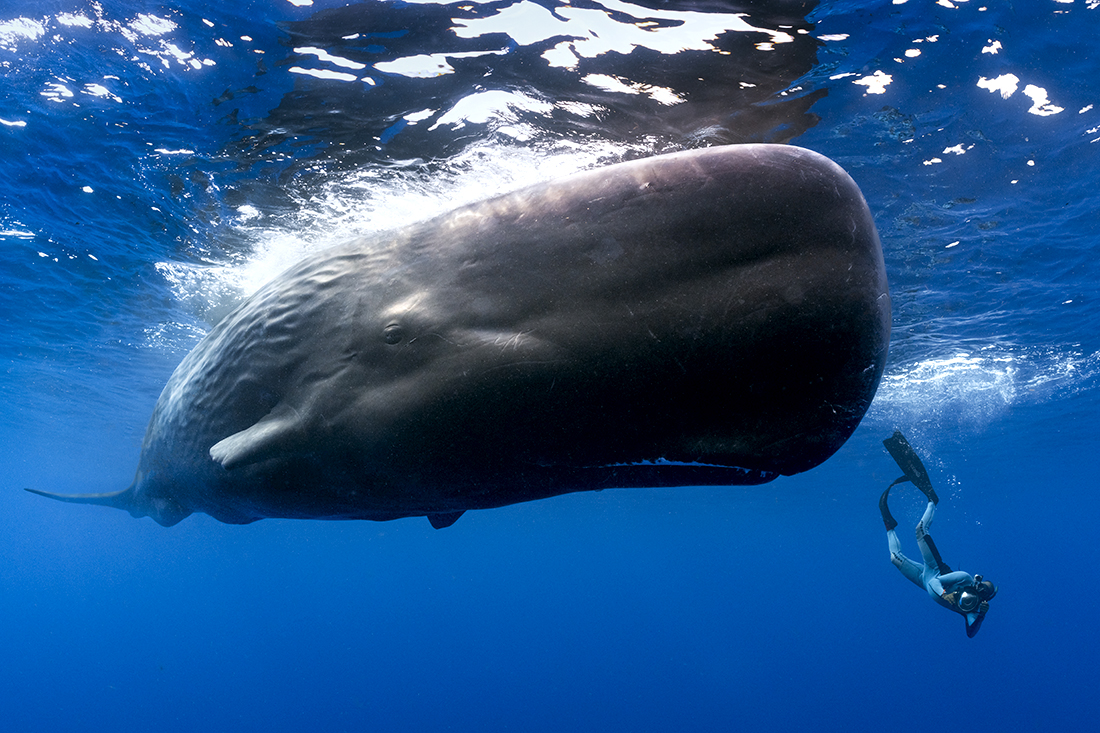
In-water encounters with something this large is an undeniably awe-inspiring experience. But, if there one thing that I have learned from prior encounters with whale sharks, humpback and pilot whales is that when something this large appears to be hardly moving, it’s still likely moving faster than you! The notion of pulling any further ahead was becoming more futile by the second with every breath through my snorkel coming in a torturous series of gasps.
Sperm whales are not the most elegant looking member of the whale and dolphin family. The most obvious feature one cannot ignore is their giant bulbous head. Referred to as the melon, this portion of the whale’s body can encompass up to 40 percent of its overall length. It is that same massive head region where the name sperm whale originated. During the heyday of 18th century commercial whaling, whalers mistook the enormous region known as the case, which contains a white oily liquid, as the whale’s seminal fluid.
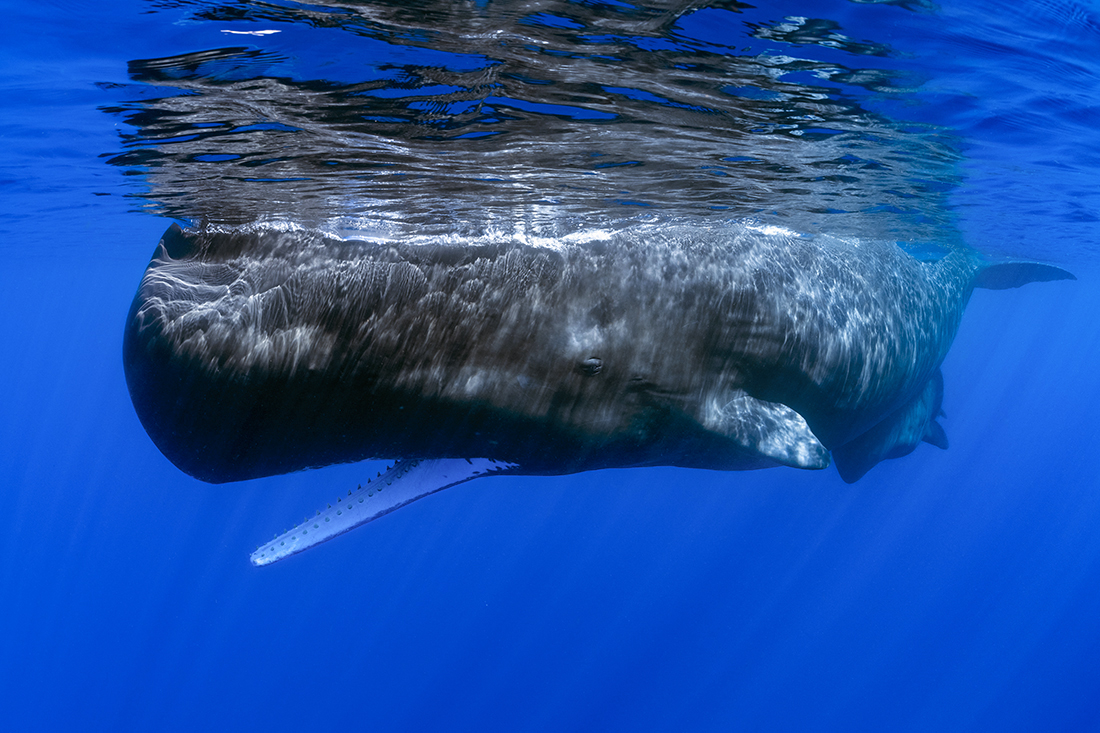
Dirty jokes aside, the spermaceti organ, which possesses as much as 530 gallons / 2,000 liters of this fluid, serves the whale as a highly specialized directional amplifier devoted to sound generation. Like all toothed whales and dolphins, sperm whales emit a wide range of high frequency clicks for echolocation. This allows them to see using sound, while a different set of clicks and whistles are used as a means for vocalized communication. What makes the sperm whale unique is that they can essentially pump up the volume, hammering out as much as 230 decibels (re 1 µPa m) in a single burst underwater; making them the loudest sound-producing animal on the planet.
In big animal encounters, what most of us hope for is a demeanor of mild curiosity rather than an air of partial indifference as the animal barely registers you on their radar. Well, be careful what you wish for!
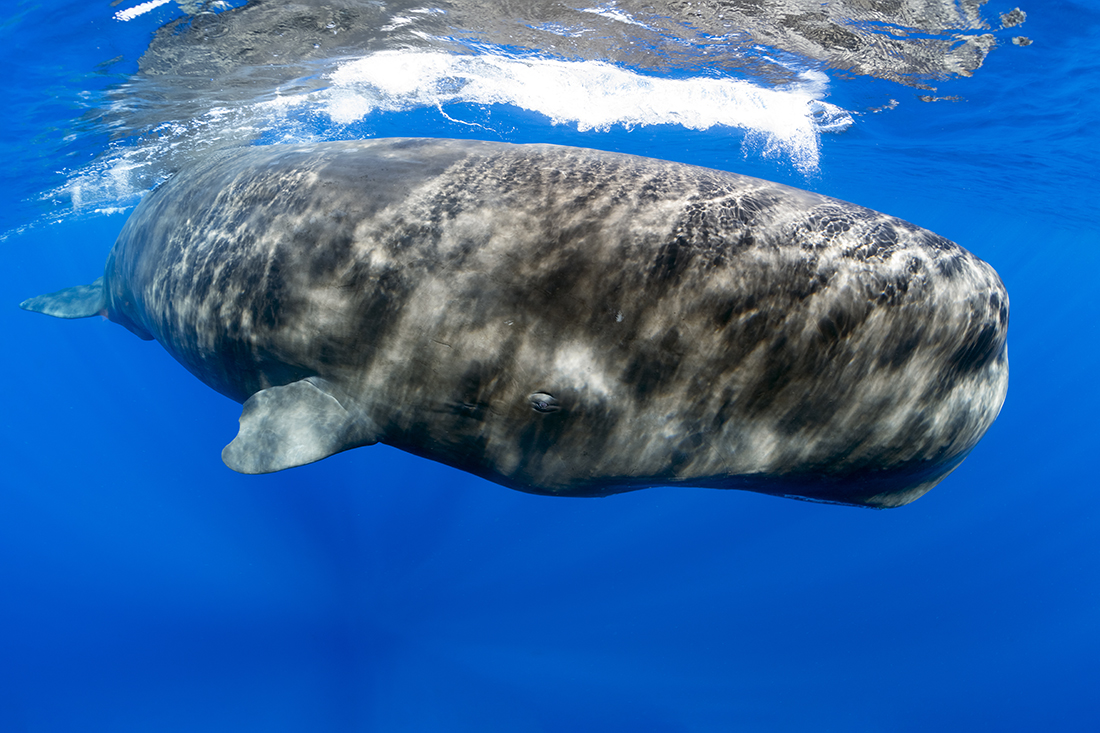
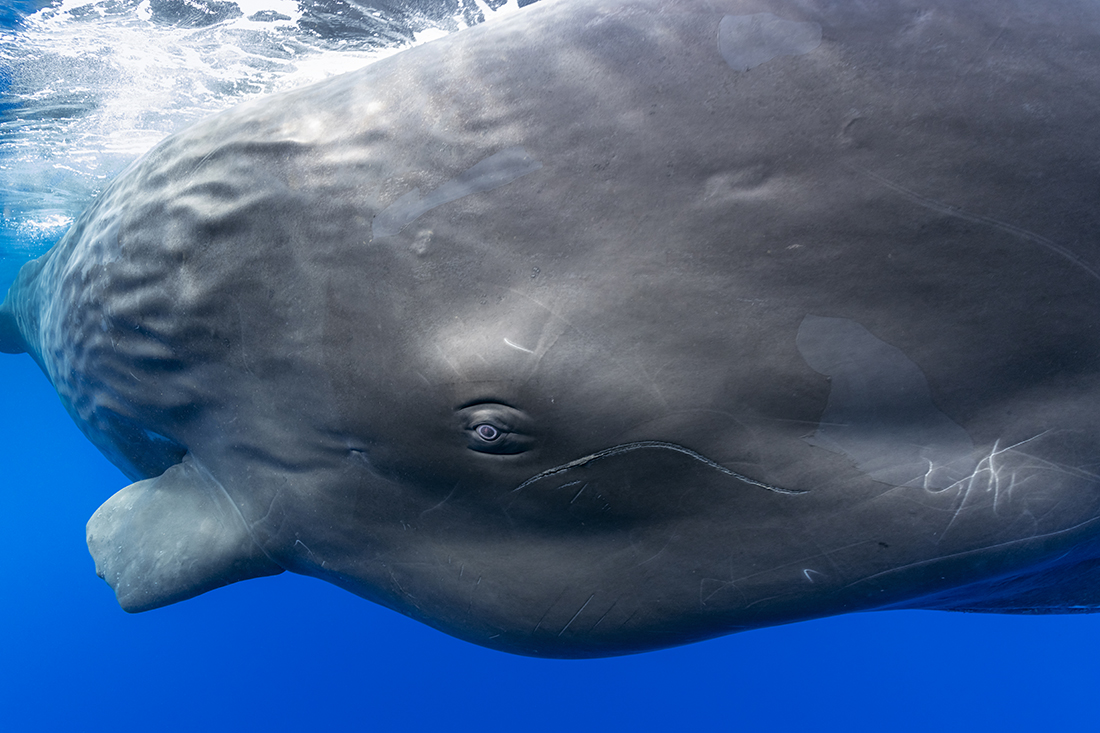
After managing to take in a deep enough breath to drop down several feet for a more desirable camera angle, the view through my camera’s viewfinder during the whale’s oh-so-casual pass became essentially a wall of black. And I was using a full-frame fish-eyed lens, through which objects are closer than they appear. Peeking over the top of my camera housing, I realized that the side of the whale’s head was less than an arm span away. Then, the whale began to turn its body slightly more broadside to get into better view of me. In that moment, the encounter had turned from a hard-pressed swim to a stationary stare-down in which time seemed to come to a standstill, with the whale gazing at me.
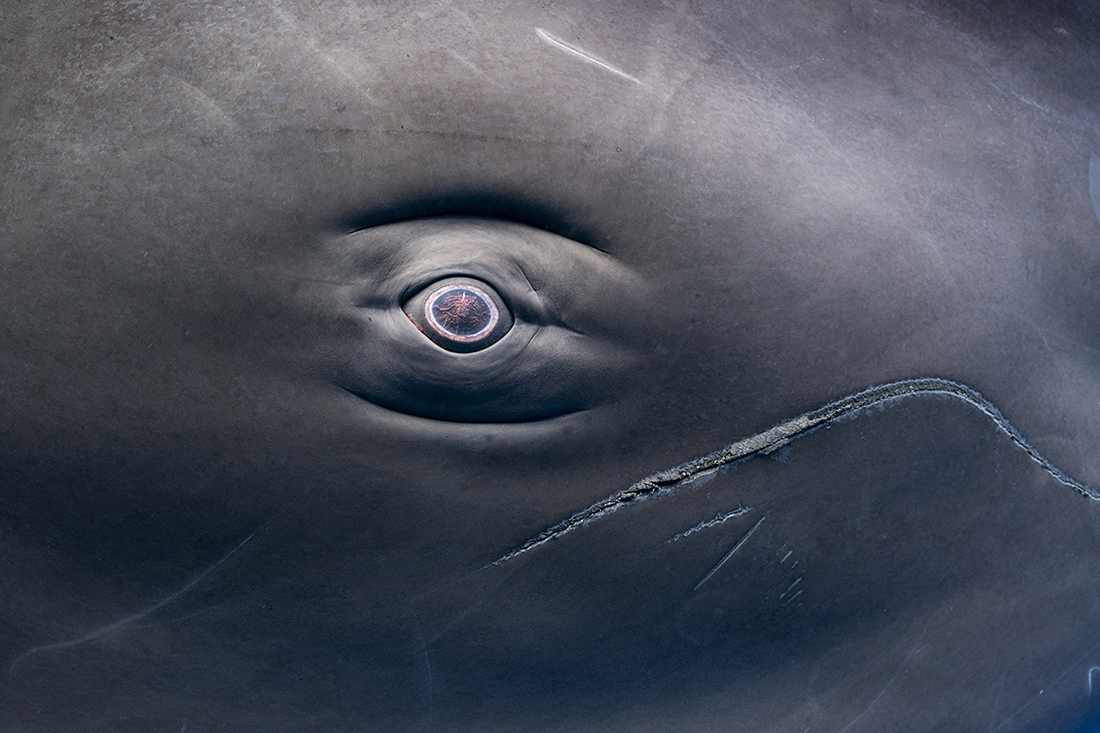
You know the adage, “the eyes are the window to your soul.” If Shakespeare had met a sperm whale, he might have paraphrased it differently in this case with “an eye is a keyhole to the soul.” This peculiar point of view (excuse the pun) is due to sperm whales having unusually small eyes in relation to their massive bodies. The eye was not much larger than a golf ball.
But behind that small eye is one of the largest brains in the animal kingdom — more than five times larger and heavier than our own. I marveled at the fact that something with such a large brain is also capable of showing complete benevolence to humans. This truck-sized creature could have easily squashed me like a grape, but instead spent a few moments puzzled by how the pathetically poor-swimming creature next to it even got here.
How Big Do Sperm Whales Get?
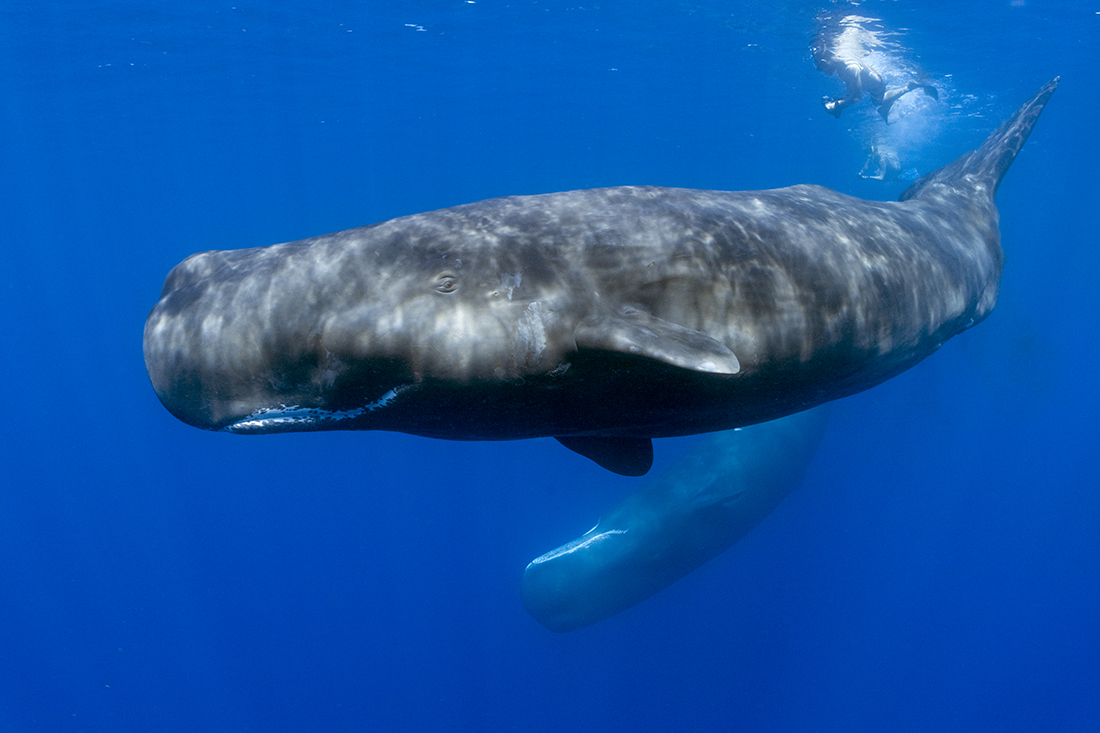
Although there is some disagreement as to the accuracy of the New Bedford whaling fleet logs during the mid 1800’s, which was the height of Yankee whaling, records of adult males taken up to 80 feet / 24 metres in length is very compelling. Particularly compelling is the historical account of one such bull sperm whale that sunk the American whaling ship Essex in 1820 by ramming it. This is the very same account that inspired Herman Melville to incorporate the attack into the story line of his literally classic “Moby Dick” in 1851.
The spell was broken by the sound of my camera’s shutter working in rapid fire succession, ripping through 12 frames at a rate of three frames per second, with most of the shots taken just a foot from the whale’s body. Then, with a single beat of her tail, she surged far ahead, leaving me with nothing to do but watch her continue on her leisurely course.
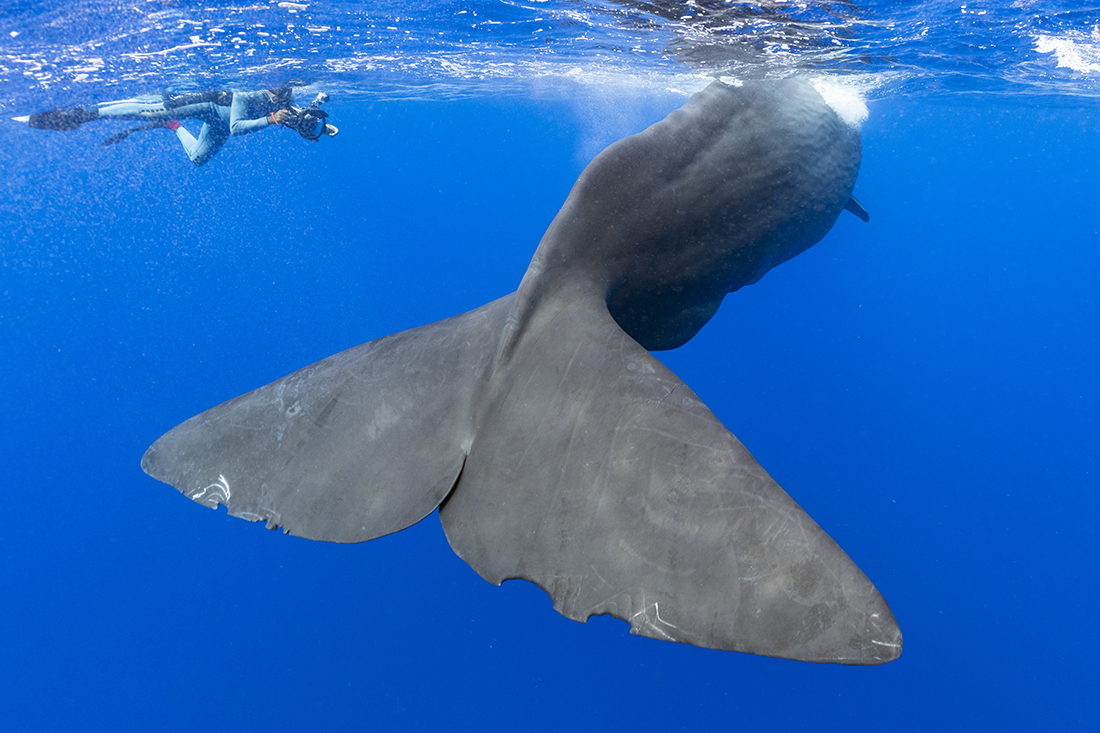
Catching my breath on the surface, our Dominica whale guide Arun ‘Izzy’ Madisetti edged up to tell me “it’s the way some encounters go. Some days they play it easy, other times it’s like racing a Ferrari with a mule cart.”
Dominica, there be Whales Here
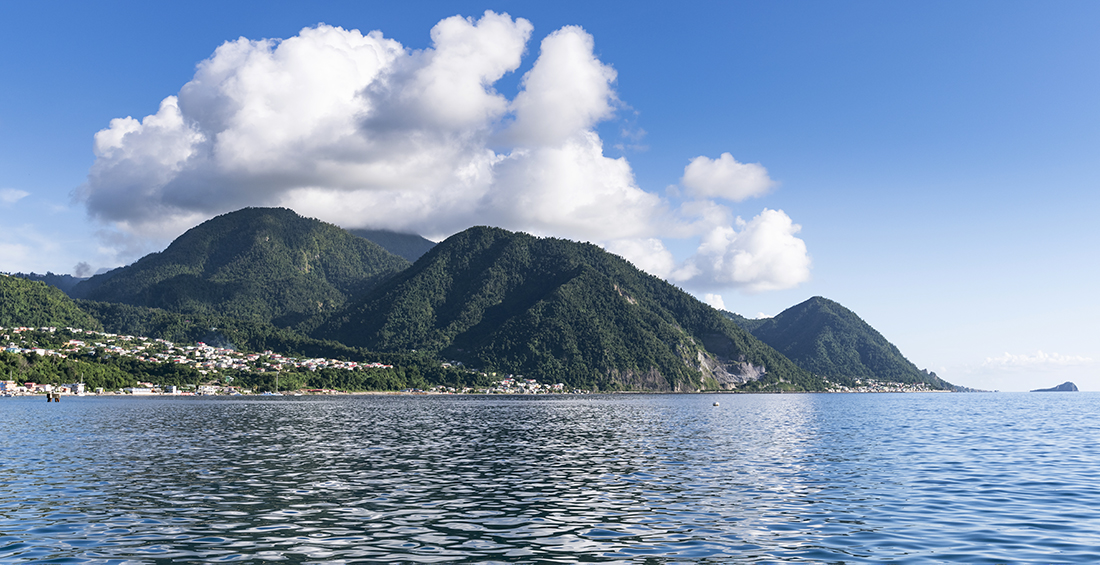
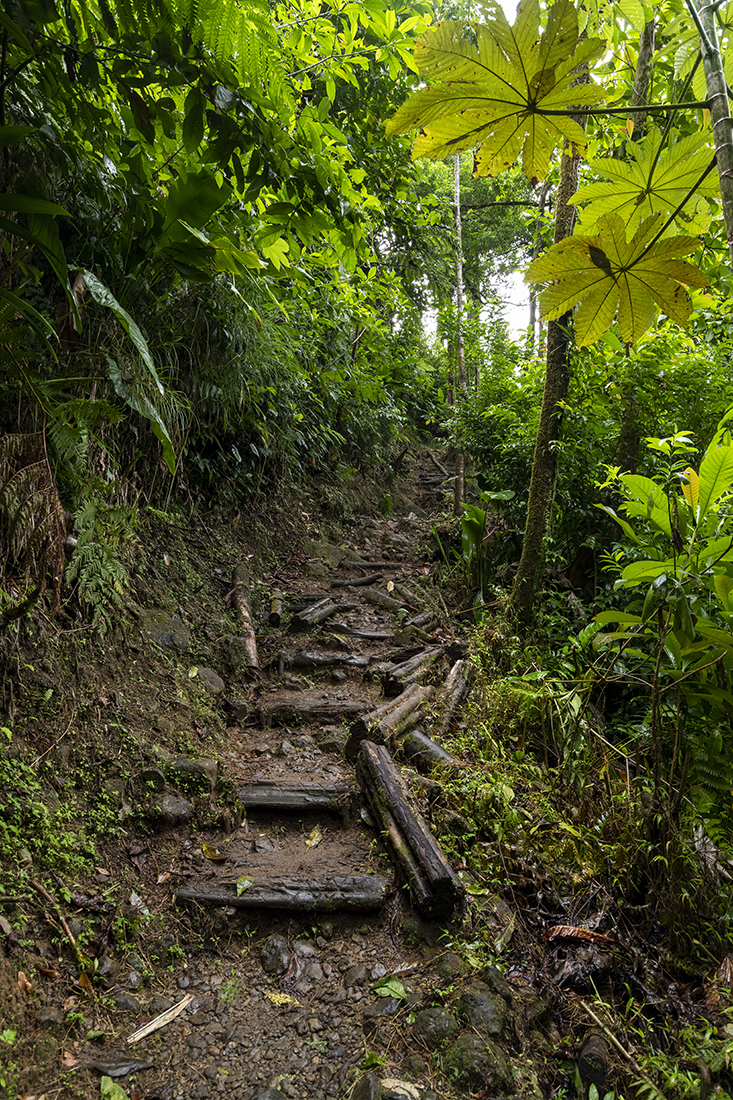
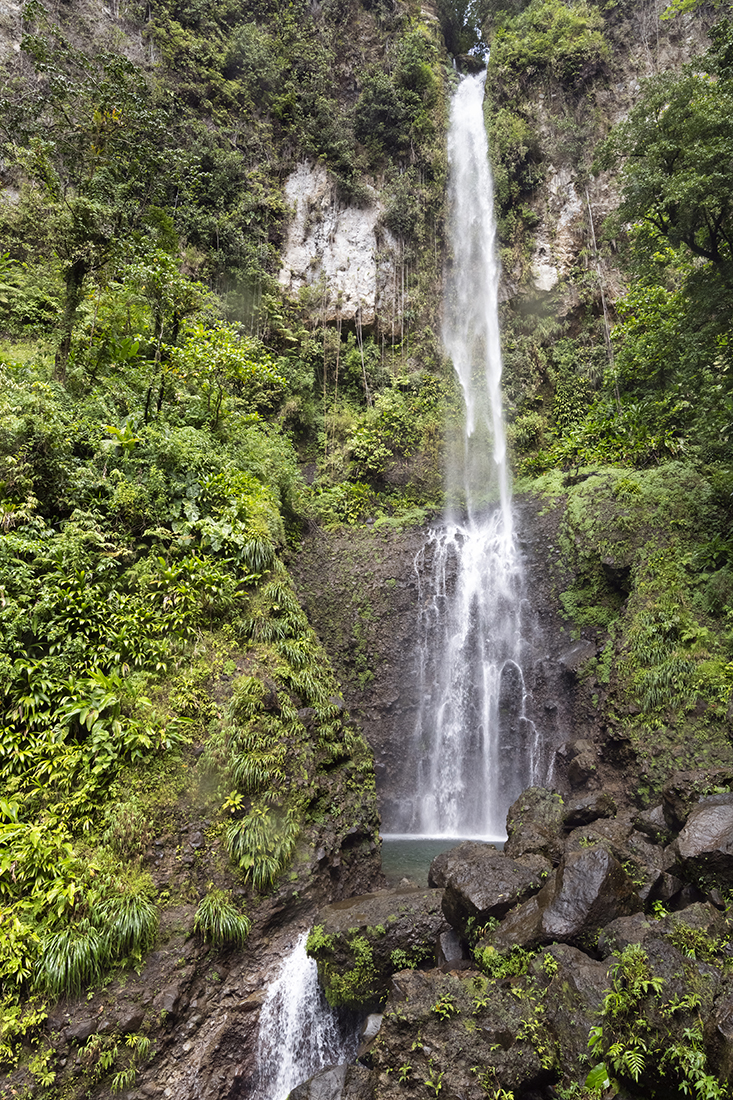
Dominica is located between the islands of Guadeloupe and Martinique, midway down the Lesser Antilles island chain. Nicknamed the Nature Island, much of Dominica’s 300 square miles of mountainous terrain remains cloaked in rainforests filled with endemic flora and fauna, rivers and waterfalls. The island’s volcanic origins remain in the form of geothermal vents that release boiling water around parts of the island. Some, forming hot springs, are safe to soak in.
I understand that the diving on Dominica’s leeward side, particularly down south of Dominica’s capital city of Roseau, is considered among the best in the Eastern Caribbean, with dramatic drop offs adorned with sponges and corals. But that’s a story that will wait for another time, because I was there for the sperm whale encounters. Dominica has the unique distinction of being one of only three really accessible places in the world where you can swim with these majestic open ocean giants.
When a good friend of mine Chris Bartlett proprietor of Indigo Safaris informed me there was an opening in this highly sought after excursion I said say no more, I am there! Booking my plane tickets to Dominica the second I was off the phone.
The Drill
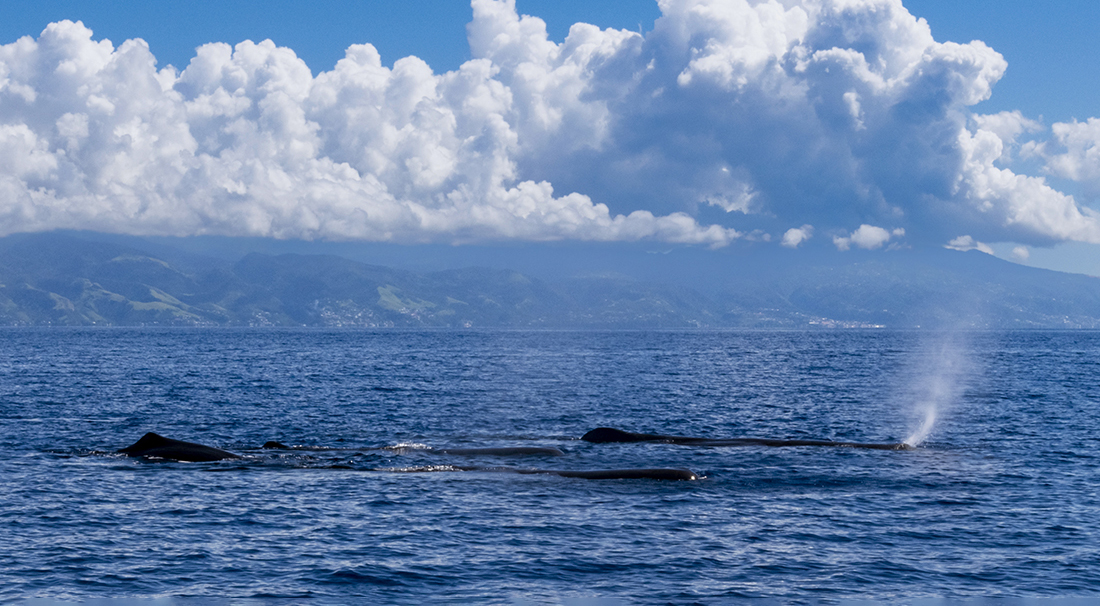
Sperm whales are pelagic in nature and typically on the move. They have a range that spans all major oceans, but there are cases such as Dominica where they may stay put for a time. Dominica’s own cetacean research and management program has collectively identified and cataloged up to 30 different year-round resident pods of sperm whales, with each pod comprised of family units of four to seven individuals living cooperatively together as they protect and nurse their young. Absent from these groups, except during mating season in the winter, are the larger mature males. They generally live solitary lives and will sometimes form bachelor groups as they range further afield in colder waters where larger prey resides.
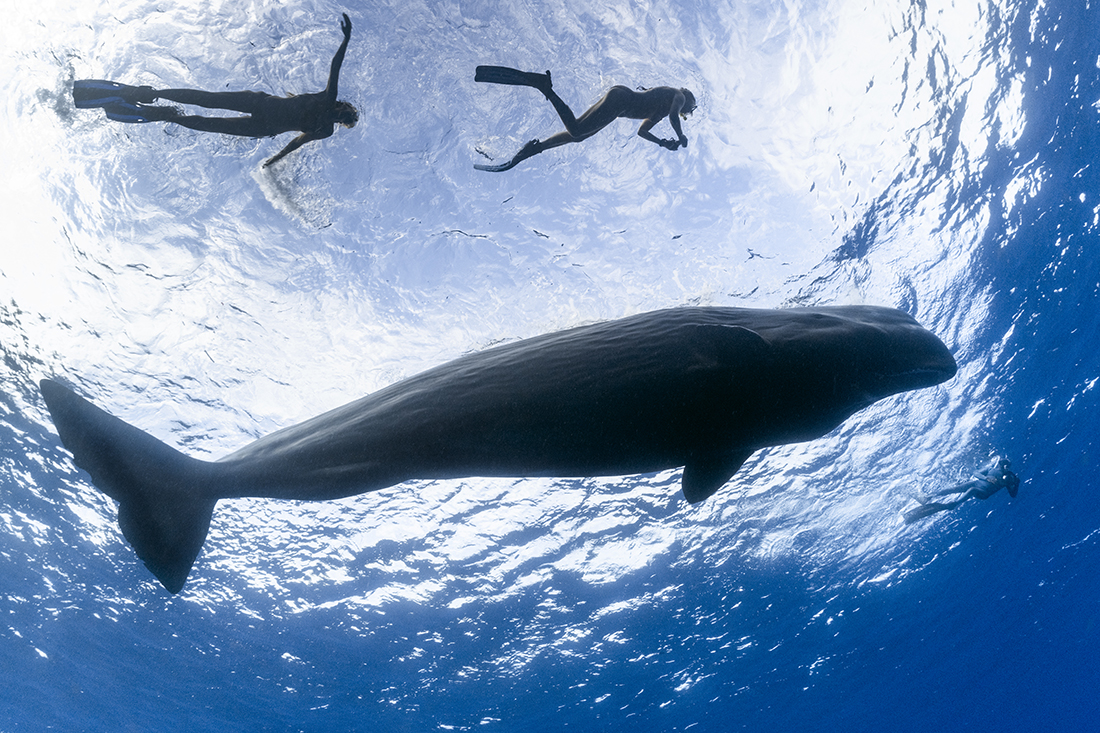
Swimming with these giants typically involves long periods of tedium randomly interrupted by bursts of excitement and anticipation. First, after getting off the dock each morning, the boat crew must determine where the whales are at. This means going 6 to 12 miles offshore, as this is where the whales hunt squid in the deep waters of the Grenada Basin that lies off the western side of the Lesser Antilles archipelago.
During the hunt, sperm whales will dive for 40 to 50 minutes at time, with surface intervals of 10 to 20 minutes in between. Sperm whales are the second deepest diving air breathing animal on the planet, exceeded only by the Cuvier’s beaked whale. They can plunge as deep as 7,382 feet / 2,250 metres. While down, they may travel up to half a mile or more before surfacing, so the trick is to be there when they come up.
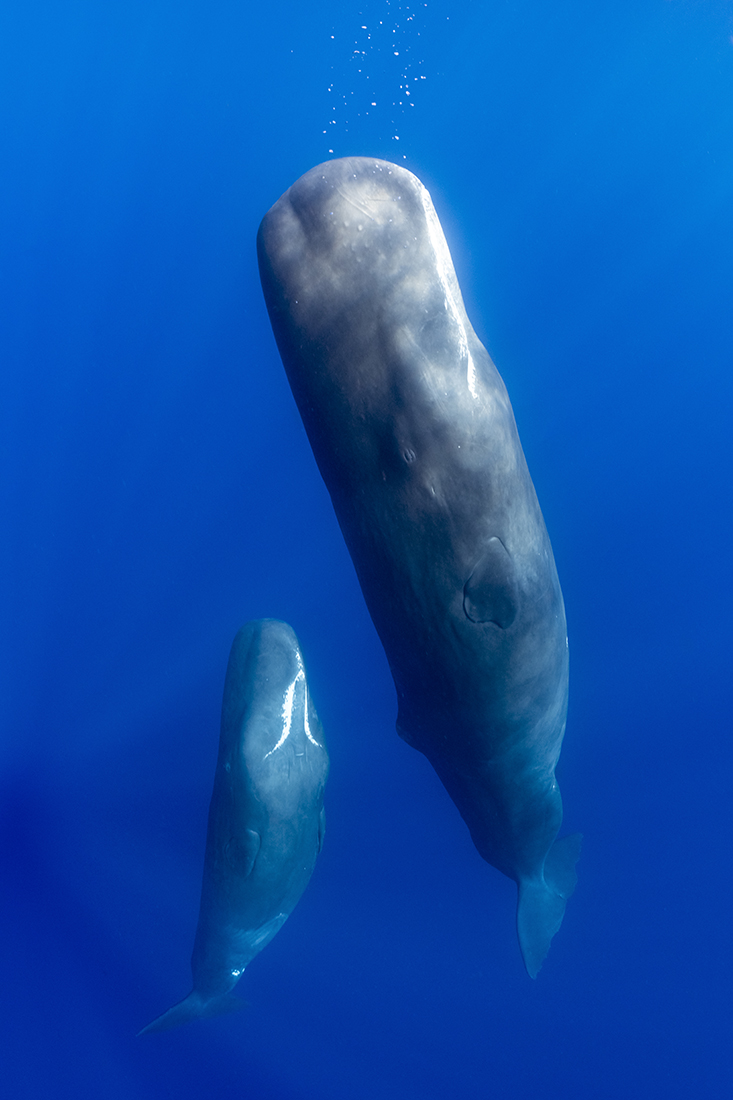
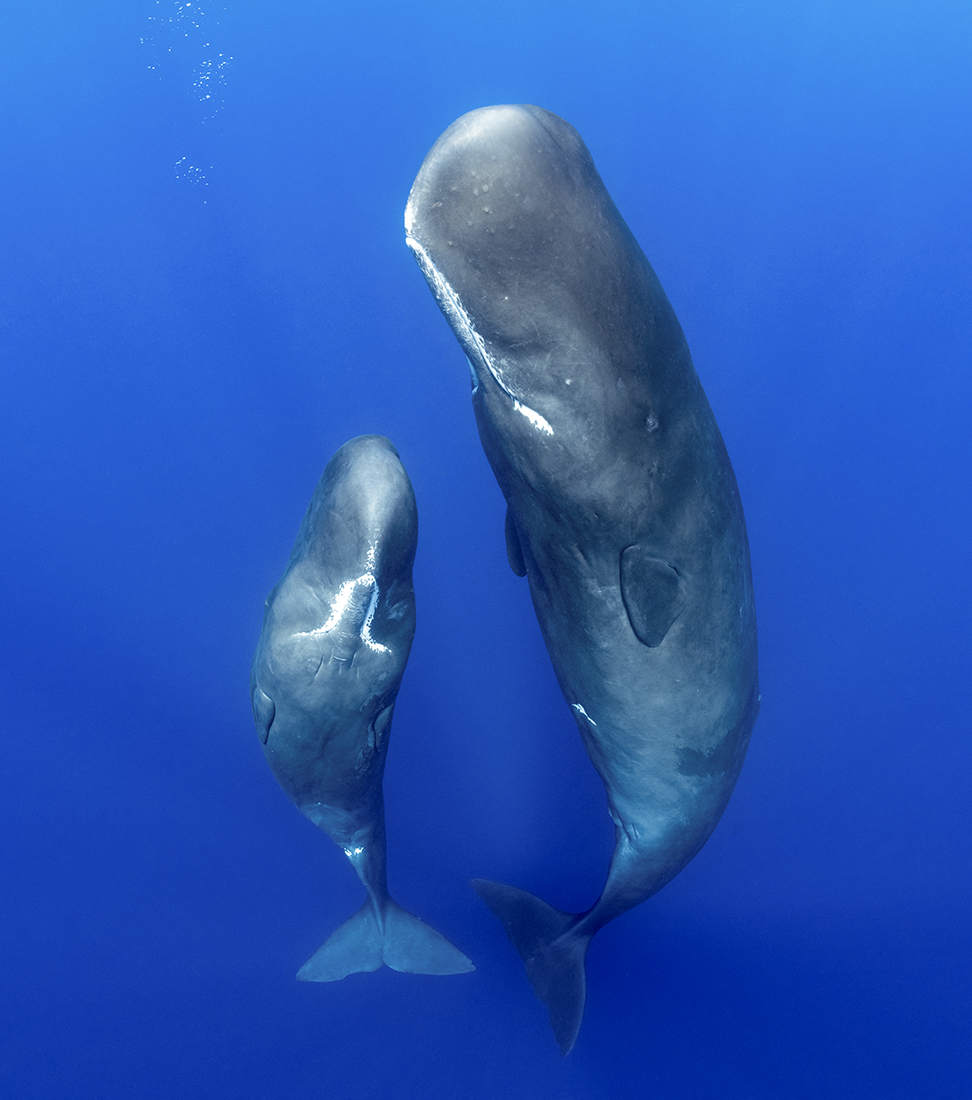
One of my personal favorites from my short time with Dominica’s sperm whales this year, is this shot of a mother her calf hanging vertical in the water column 30 feet below the surface. A calf is completely dependent on its mother’s milk for the first two years of it is life, but often stay with her another 2 to 3 years.
To determine where to be, our guides would hang a directional hydrophone overboard to listen for the clicks the whales make during their dive, using that information to identify the direction the whales are working. Once a whale surfaces, the captain then slowly coasts the boat a few hundred feet ahead of the whale’s path, affording swimmers a chance to slide in with minimal noise and wait for the whales to make the next move.
Dependent on their mood, interactions with these big girls can run from as short as a few seconds to as long as an hour. These longer sessions most often to take place when a calf in the 2 to 4-year-old range is present.
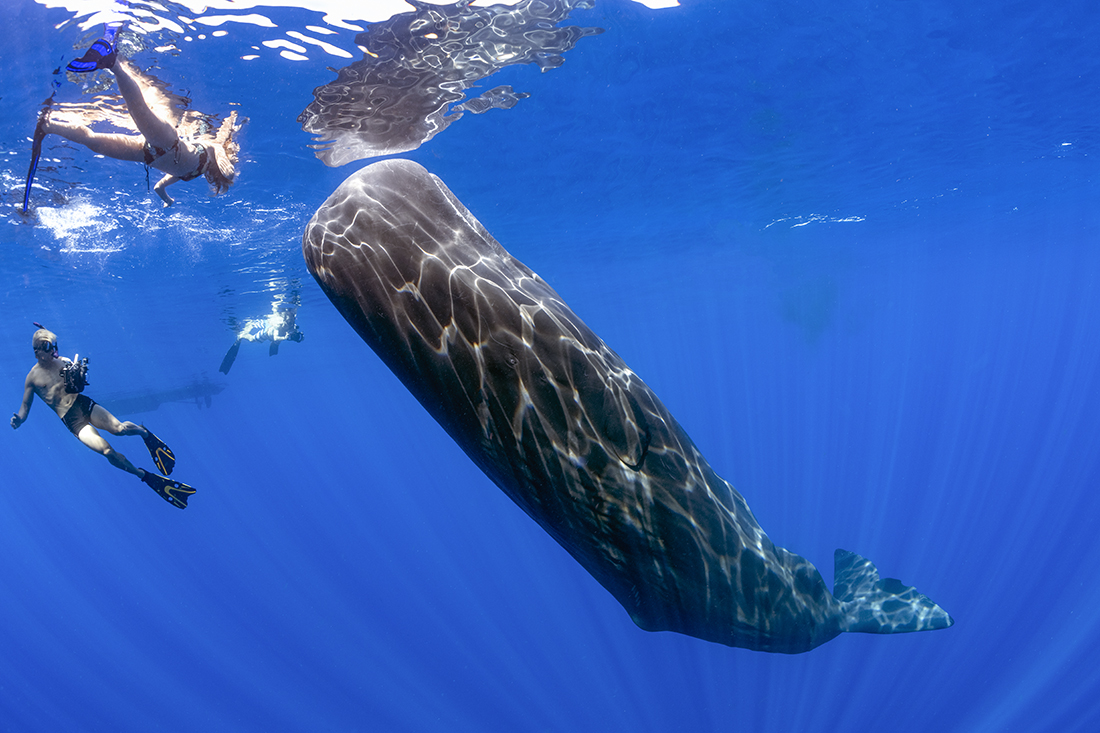
To make sure encounters are kept as low-impact as possible, in-water whale excursions are limited to three snorkelers plus a whale guide at any one time, and require a permit, which is issued on a limited basis by Dominica’s Dept. of Agriculture and Fisheries. To ensure everyone gets a fair shot, groups are usually limited to six people. This actually works better for underwater photographers than it does for the whales, as it reduces the probability of getting in each other’s way for the shot. As for the whales, the presence of swimmers is likely old hat, as this program has been going on for a number of years.
Category-4 Poo-Nado
Sperm whales are NOT the ferocious, loathsome creatures of lore. In fact, there has never been an incident of a whale injuring anyone in Dominica. But there is one danger to keep in mind.
As a wildlife photographer, one strives to capture the majestic beauty of their subject. Sometimes you achieve that goal. Other times, things don’t go well, which was the case
during one particular interaction we were having with mother and her relatively older calf (roughly 2 to 3 years of age). At first, everything we hoped for was taking place, with the calf highly inquisitive and playfully rolling around, while mom just remained as placid as can be.
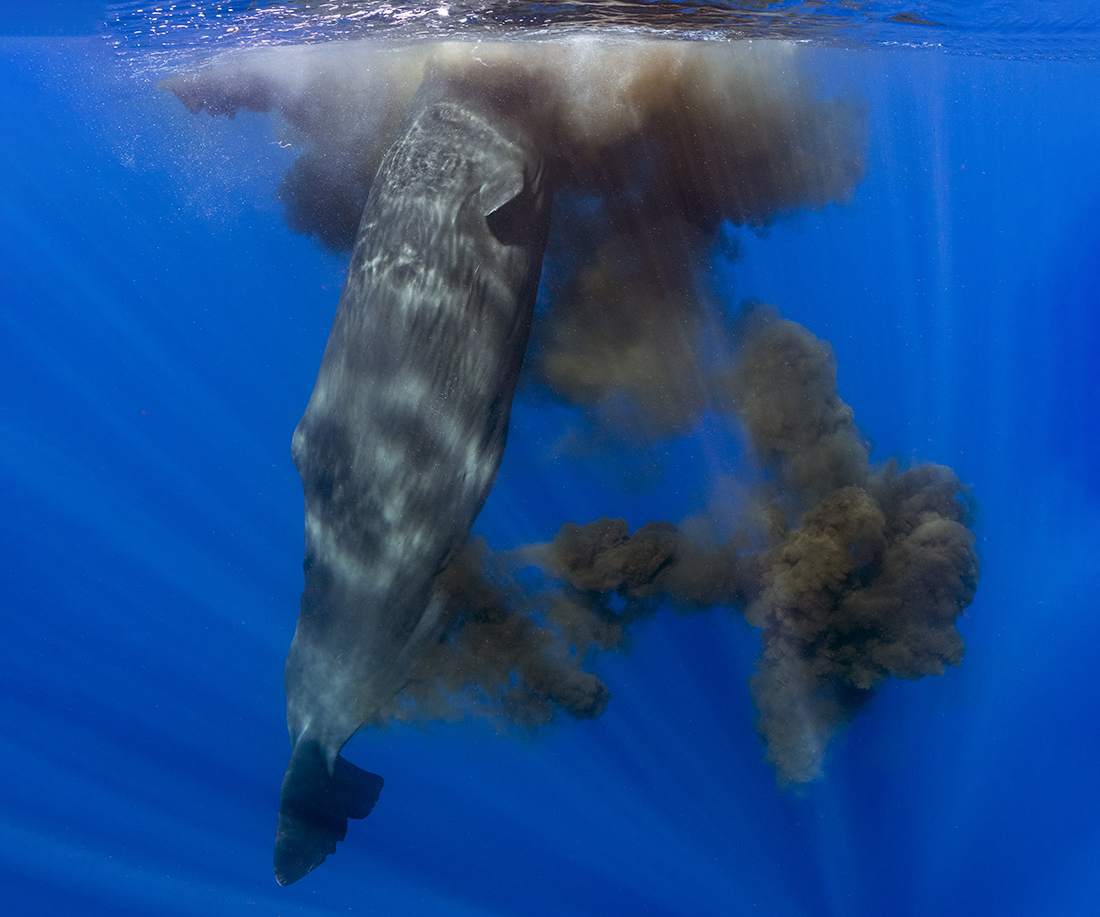
What I witnessed next could fittingly be described as a high-powered explosive inside a fully loaded septic tank. This happened just as the calf reached an inverted position during one of those rolls, and decided it was time to take a poop. In a nanosecond, my thoughts turned to “holy crap!” Before I knew it, my instincts had kicked in with me hastily back peddling to stay clear of the rapidly growing whale poo-nado!
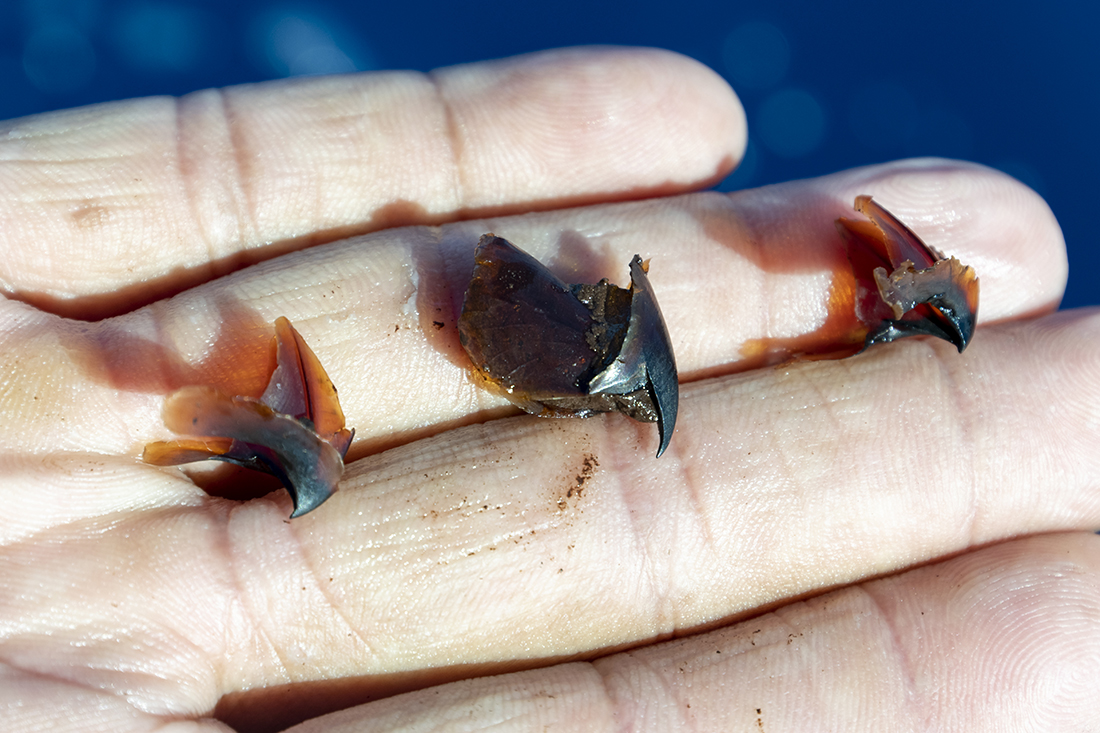
Fine Ladies & Gentlemen Wear It
What do sperm whales and high-priced perfume have in common? If you don’t want to know, read no further.
For centuries the manufacturing of fine perfume relied on a vital ingredient called ambergris, for its properties as a highly efficient fixative that made the scent in a given perfume last a significant amount of time. For a long period of time, the origin of this substance remained a mystery. This was largely because the only source for ambergris was in the form of large dull-grey to almost black colored nodules with a strange waxy texture that washed up on shore. It wasn’t until the advent of large-scale whaling in the 1800s that ambergris was discovered to be a byproduct of a sperm whale’s digestive system.
The irony of this was not lost on Herman Melville, author of Moby Dick, who pointed out in the story that “fine ladies and gentlemen should regale themselves with an essence found in the inglorious bowels of a sick whale.”
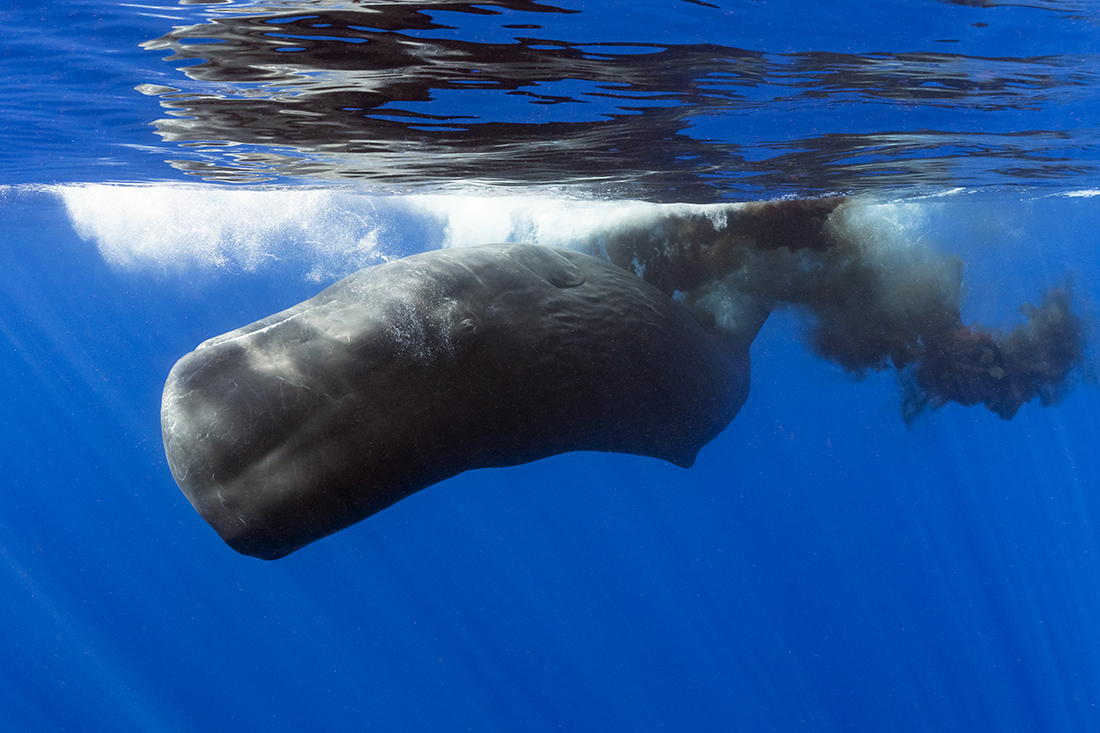
When freshly extricated, ambergris starts off having a very foul fecal odor. But as it ages it acquires an earthy, somewhat sweet fragrance liken to rubbing alcohol without the vaporous chemical astringency. Although the use of ambergris has been mostly replaced by more readily available synthetics such as ambroxan, ambergris is still very much in demand. This is evident by the going rate for aged ambergris, which can run as high as $20,000 per kilogram, making it the most expensive shit in the world.
I guess the lesson to be learned is that when one of these behemoths decides to defecate, it’s never going the be in small measure. Nor should we forget, that this is nature in all its grandeur and splendor. And when you are in the company of giants, expect the unexpected.
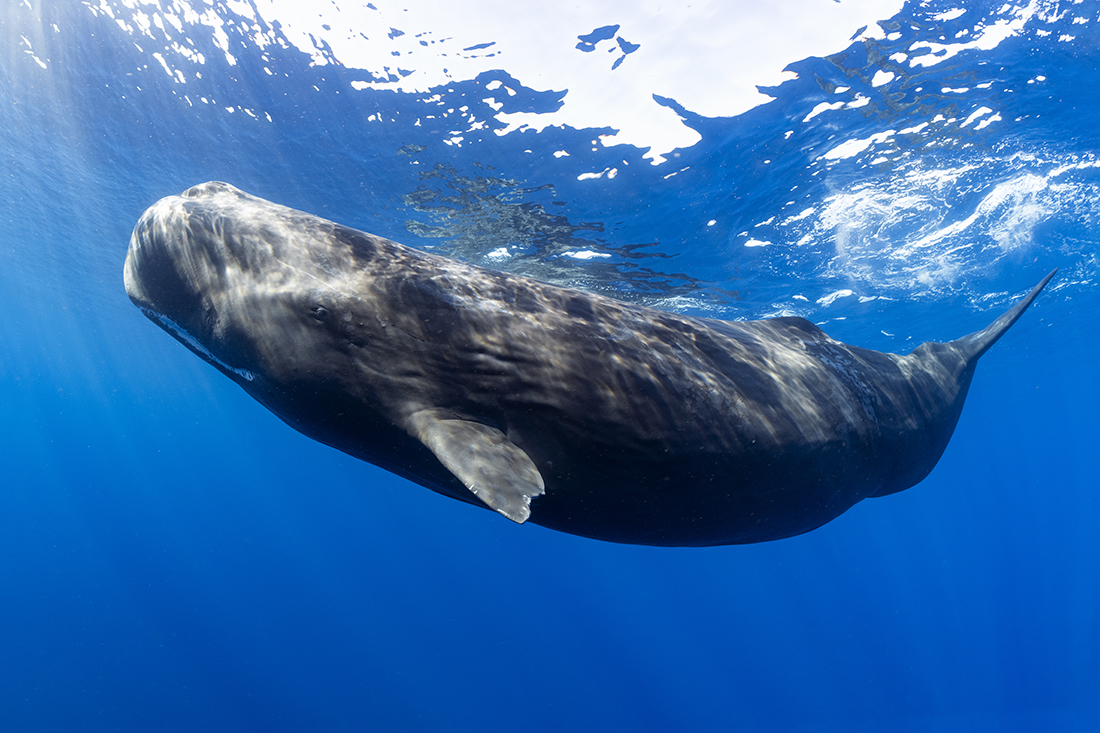
All Sperm whale images taken under permit from Dominica’s Department of Agriculture and Fisheries.

